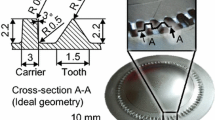Abstract
Sheet-Bulk Metal Forming (SBMF) allows the manufacture of complex parts with integrated functional form elements, such as teeth and thickened areas. Therefore, bulk forming operations are applied to sheets with initial thicknesses of 2 or 3 mm. The design and functionality of the tools are as important as the process itself. Therefore, the working group “Tools” of the Transregional Collaborative Research Centre on Sheet-Bulk Metal Forming (CRC/TR73) focuses on the optimization of the technical tool design. By varying topographies or applying tailored coatings, the friction behavior is changed to achieve a better form filling and to reduce process forces during the forming operations. In this paper, the potential of different tailored surfaces is validated by simulations and experimental studies. The tribological behavior of 14 surface microstructures is evaluated using a half-space model in order to select structures suitable for application. Those were characterized experimentally by ring-compression and pin-extrusion tests. The determined friction factors were used in a forming simulation to predict the form filling of small cavities in a flow forming operation. Furthermore, special attention is paid to the utilization of the anisotropic behavior of specific structures. The results were validated by an incremental gear forming process.





















Similar content being viewed by others
References
Merklein M, Allwood JM, Behrens B-A, Brosius A, Hagenah H, Kuzman K, Mori K, Tekkaya E, Weckenmann A (2012) Bulk forming of sheet metal. CIRP Ann 61(2):725–745
Gröbel D, Koch J, Vierzigmann U, Engel U, Merklein M (2014) Investigations and approaches on material flow of non-uniform arranged cavities in sheet bulk metal forming processes. Procedia Eng 81:401–406
Löffler M, Gröbel D, Engel U, Andreas K, Merklein M (2015) Analysis of effectiveness of locally adapted tribological conditions for improving product quality in Sheet-Bulk Metal Forming. Appl Mech Mater 794:81–88
Hetzner H, Koch J, Tremmel S, Wartack S, Merklein M (2011) Improved Sheet Bulk Metal Forming Processes by Local Adjustment of Tribological Properties. J. Manufacturing Science and Engineering 133(6):61011-1-11
Sieczkarek P, Kwiatkowski L, Tekkaya AE, Krebs E, Kersting P, Tillmann W, Herper J (2013) Innovative tools to improve incremental bulk forming processes. Key Eng Mater 554–557:1490–1497
Sieczkarek P, Kwiatkowski L, Tekkaya AE et al (2012) Improved tool surfaces for incremental bulk forming processes of sheet metals. Key Eng Mater 504–506:975–980
Freiburg D, Biermann D, Hense R, Stangier D, Tillmann W (2015) Influence of surface modifications on friction, using high-feed milling and wear resistant PVD-coating for sheet-metal forming tools. Key Eng Mater 639:275–282
Suresh R, Basavarajappa S, Gaitonde VN, Samuel G, Davim JP (2013) State-of-the-art research in machinability of hardened steels. Proc Inst Mech Eng Part B J Eng Manuf 227(2):191–209
Hogmark S, Jacobsen S, Wänstrand O (1999) A new universal test for tribological evaluation. In: Proceedings of the 21st IRG-OECD Meeting, Amsterdam, Netherlands
Hetzner H, Schaufler J, Tremmel S, Durst K, Wartzack S (2012) Failure mechanisms of a tungsten-modified hydrogenated amorphous carbon coating in load-scanning tests. Surf Coat Technol 212:46–54
Ahn S-K, Kwon S-H, Kim K-H (2011) Effect of carbon on microstructure of CrAlCxN1-x coatings by hybrid coating system. Trans Nonferrous Met Soc China 21:78–82
Sobis T, Engel U, Geiger M (1994) A theoretical study of wear simulation in metal forming processes. J Mater Process Technol 34:233–240
Pfestorf M, Engel U, Geiger M (1998) 3D-surface parameters and their application on deterministic textured metal sheets. Int J Mach Tools Manuf 38:607–614
Leach R (2013) Characterisation of areal surface texture. Springer, Berlin
Kalker JJ (1990) Three-dimensional elastic bodies in rolling contact, Vol 2. Springer, Netherlands
Hauer F, Willner K (2013) Development of a Friction law respecting plastic surface smoothing. Key Eng Mater 554:1471–1477
Hauer F (2014) Die elasto-plastische Einglättung rauer Oberflächen und ihr Einfluss auf die Reibung in der Umformtechnik. Erlangen, Germany, Friedrich-Alexander-University Erlangen-Nürnberg, Diss. (Schriftenreihe Technische Mechanik, ISSN 2190-023X)
Engel U, Neudecker T, Popp U (2000) 3D-Oberflächenanalyse - Methoden, Kenngrößen, Anwendungen. Materialwiss Werkstofftech 31:747–753
Hense R, Kersting P, Vierzigmann U, Löffler M, Biermann D, Merklein M, Wels C (2014) High-feed milling of tailored surfaces for sheet-bulk metal forming tools. Prod Eng Res Devel. doi:10.1007/s11740-014-0597-0
Male AT, Cockcroft MG (1964) A method for the determination of the coefficient of friction of metals under condition of bulk plastic deformation. J Inst Metal 93:38–46
Rajnesh T, Nath SK, Ray S (2002) Effect of martensite content on friction and oxidative wear behavior of 0.42 Pct carbon dual-phase steel. Metall Mater Trans A 33(11):3479–3488
Hetzner H, Zhao R, Tremmel S, Wartzack S (2013) Tribological adjustment of tungsten-modified hydrogenated amorphous carbon coatings by adaption of the deposition parameters. In: Bouzakis MK-D, Bobzin K, Denkena B, Merklein M (eds) 10th international conference THE “A” Coatings. Shaker, Aachen, pp 39–49
Vierzigmann U, Merklein M, Engel U (2010) tailored surfaces in sheet-bulk metal forming. In: Felder E, Montmitonnet P (ed) Proceedings of 4th international conference on tribology in manufacturing processes (ICTMP), Transvalor–Presses des MINES, pp 541–550
Acknowledgments
This work was supported by the German Research Foundation (DFG) within the scope of the Transregional Collaborative Research Centre on Sheet-Bulk Metal Forming (CRC/TR73, Workgroup “Tools”, Subprojects A2, A4, B2, B3, B4, B5, B6, and C1).
Author information
Authors and Affiliations
Corresponding author
Rights and permissions
About this article
Cite this article
Kersting, P., Gröbel, D., Merklein, M. et al. Experimental and numerical analysis of tribological effective surfaces for forming tools in Sheet-Bulk Metal Forming. Prod. Eng. Res. Devel. 10, 37–50 (2016). https://doi.org/10.1007/s11740-015-0651-6
Received:
Accepted:
Published:
Issue Date:
DOI: https://doi.org/10.1007/s11740-015-0651-6




